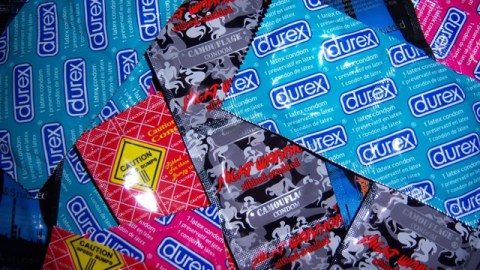A Racial Gap in Condom Use

According to a new, nationally representative, dataset released this week a gap has emerged between the races in the U.S. It’s not an income, education, or a marriage gap—it’s a condom gap. Black Americans use condoms during vaginal intercourse significantly more than white Americans. This encouraging news on condom use might suggest hopes for a reversal in the trend in which black Americans have had a much higher prevalence of STIs than the rest of the population. Right now the evidence is preliminary, but with such a rich dataset available economists should be able to determine the factors that contribute to this difference in condom use behaviour between racial groups.
According to the Centers for Disease Control, gonorrhea rates among black American women under the age of 20 are 12 times higher than for white women in the same age group (927 per hundred thousand compared to 80 per hundred thousand), and 16 times higher among women older than 20 (772 per hundred thousand compared to 47 per hundred thousand). It might be easy to assume that a lower rate of condom use is a contributing factor to the differences in STI prevalence but this new evidence suggests that is not the case. Thirty-seven percent of black men used a condom the last time they had vaginal intercourse compared to only 22% percent of white men. The difference when you look at men under the age of 50 is even more striking; in that age group, the condom use of black men is double that of white men (for example in the 40-49 age group 43% of black men used a condom the last time they had intercourse compared to 19% of white men). So condom use may not explain difference in disease prevalence—but what explains differences in condom use?
Well, one possible explanation may be the marriage gap between the races. White men are twice as likely to be married as black men (in this particular sample only 26% of black men were married compared to 48% in the all-race sample). With condoms used more frequently in casual sex than in sex with a relationship partner, this suggests that part of the condom gap can be explained by the marriage gap.
Another reason why condom use varies by race has to do with education. In the sample men with a bachelor’s degree are significantly more likely to use a condom than men with a high school education or less. But with only 18% of black men in the sample holding a college degree (compared to 29% in the all-race sample) this argument can’t explain why the condom-gap is in favour of black men. In fact it suggests that if you control for the education gap, the condom gap is even bigger than the preliminary evidence suggests.
We already know that condom use rates are related to the prevalence of disease in a particular population, so maybe while condom use can’t explain STI prevalence perhaps STI prevalence explains condom use. Surely there is nothing like having had gonorrhoea or syphilis, or having a friend or family member with an STI, to convince you that wearing a condom is a good idea. The very high rates of STI testing among black individuals in this sample (84% of black men and women have had an HIV test and 81% have been tested for other STIs) supports this argument; experience with STIs has encouraged more cautious behaviour.
This is just the beginning of the discussion, obviously, but I do have one comment to make about the data. If I wanted to be able to say something about the sexual behaviour of individuals, and I wanted to make comparisons between races, I would have asked the people I am surveying the race of the person they are having sex with. Implicit in this evidence is the assumption that either sexual behaviour is an individual choice, as opposed to joint decision between two individuals, or that individuals are always sexually active with someone of the same race. The first assumption is almost always not true and, in fact, how couples bargain over decisions like condom use is an interesting question. The second assumption may almost always be true (and the same-race marriage statistics suggest that it is) but I don’t think that it is a good starting place for an analysis.
Economists have looked at same-race preference in the marriage market. That is an interesting issue that Dollars and Sex will discuss next week.




